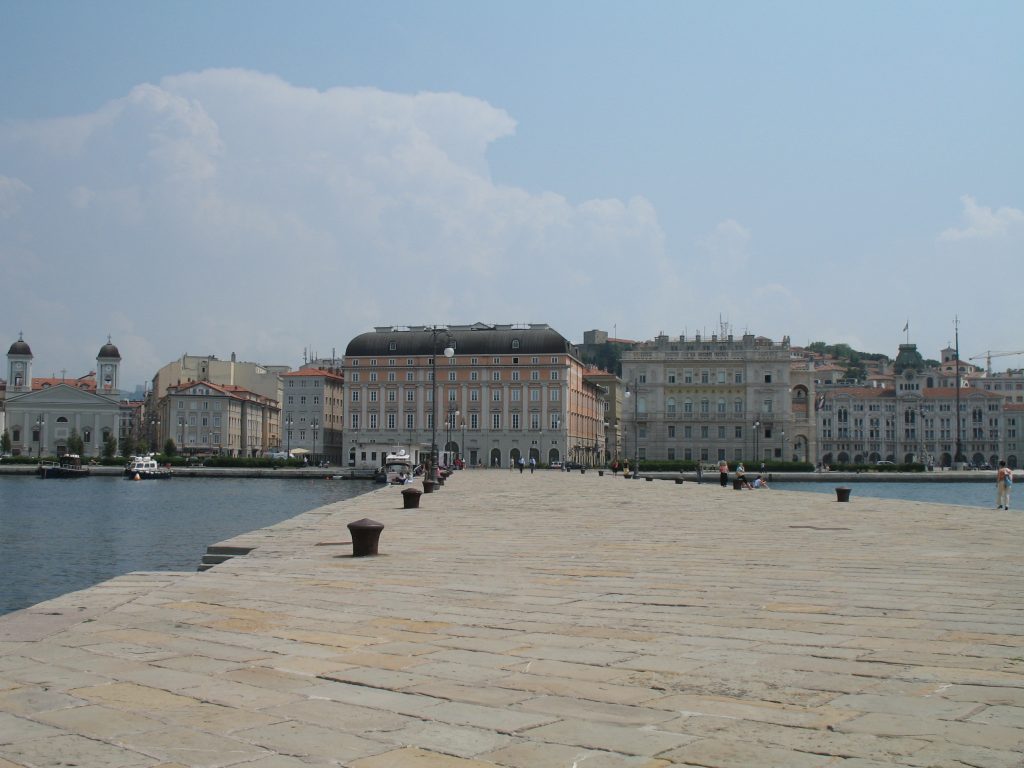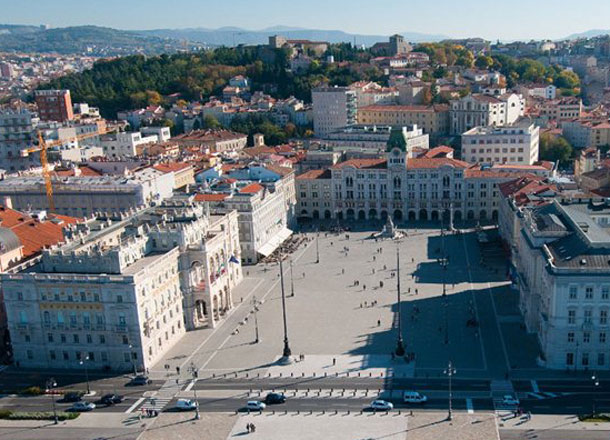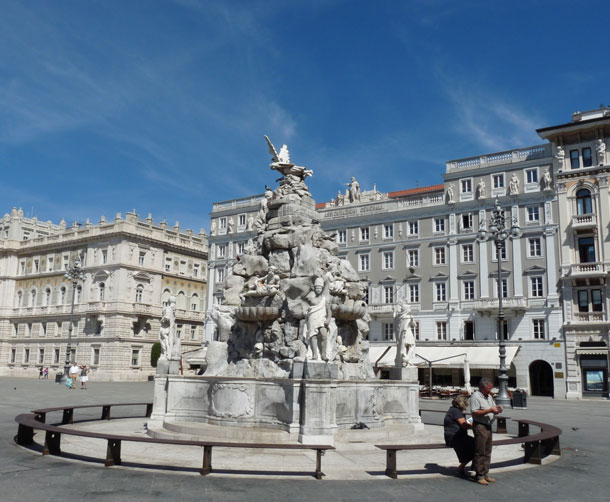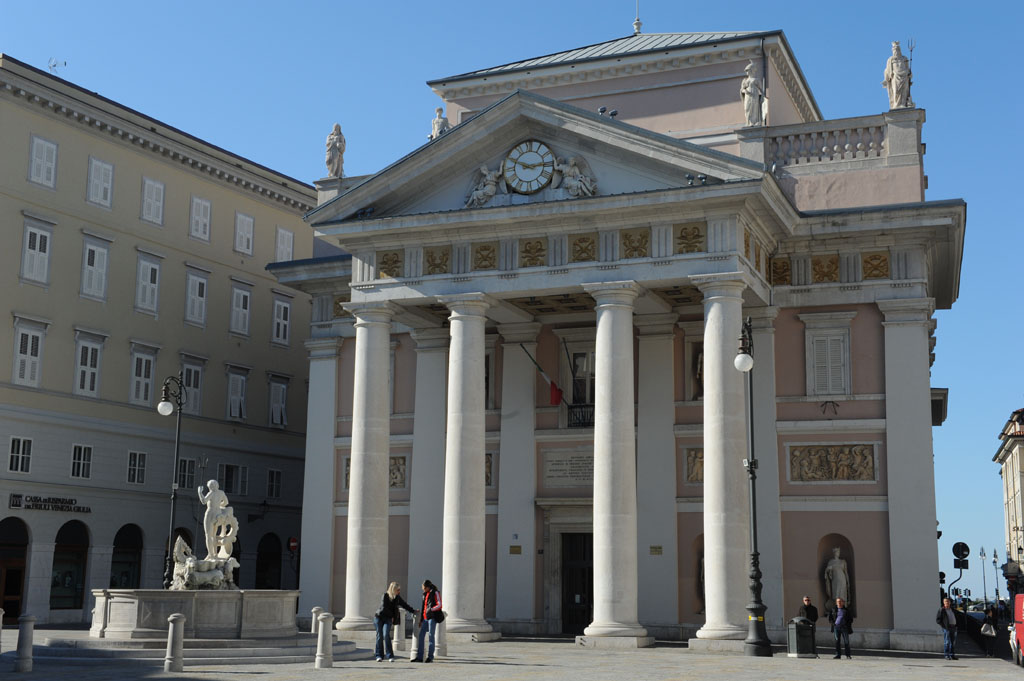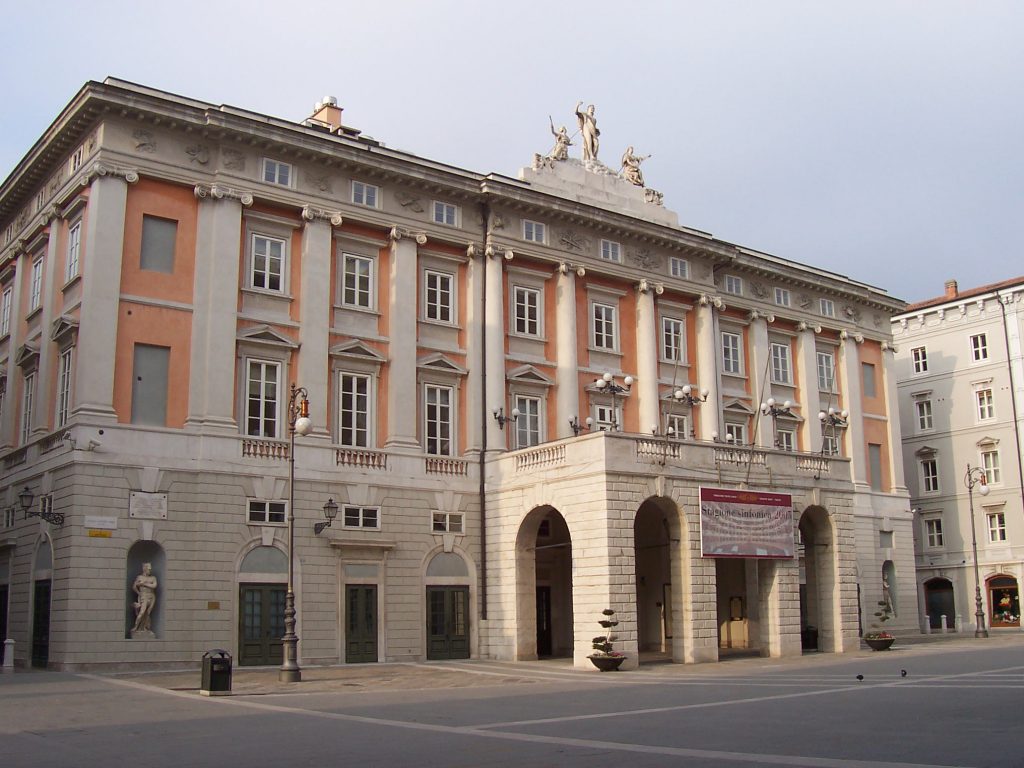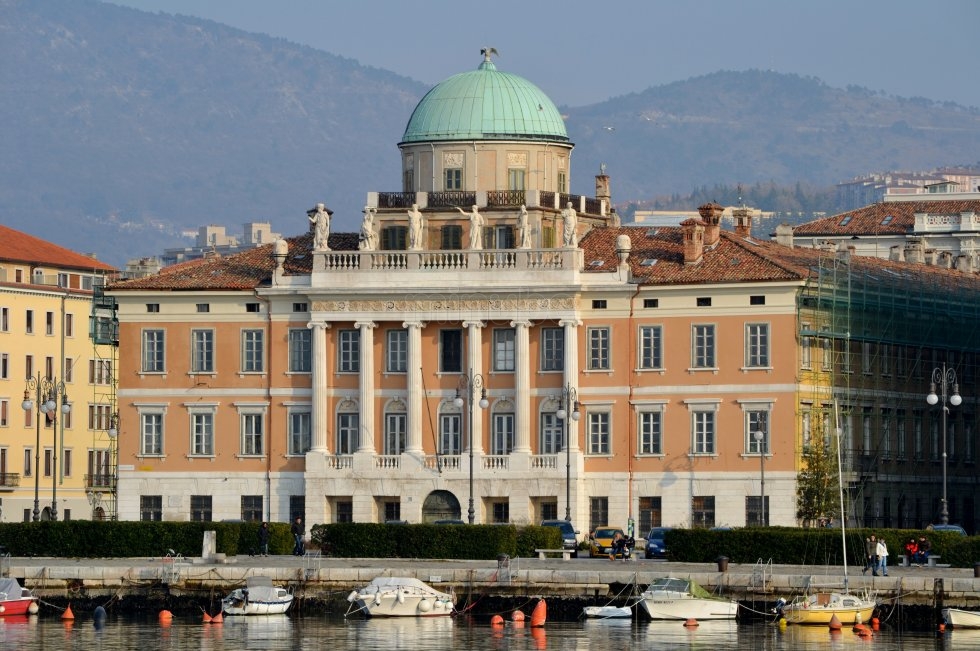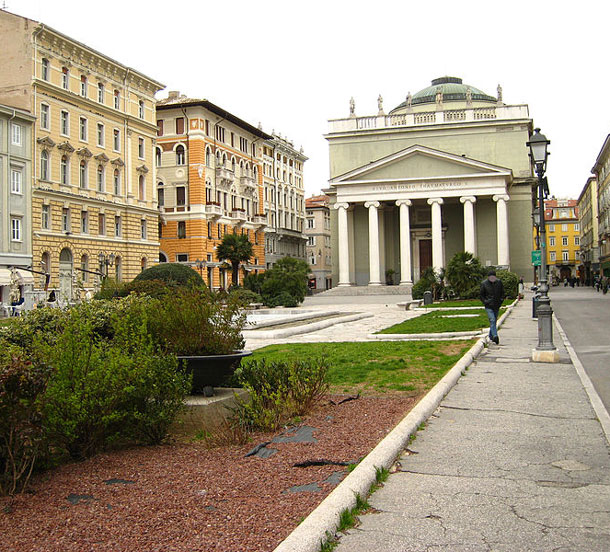The route starts from the Trieste Marine Aquarium to RIVA NAZARIO SAURO until RIVA CADUTI PER L’ITALIANITÀ DI TRIESTE
Walking alone the banks, you can see two different stones: limestone, on the edges and sandstone on the pavement of the banks (where there is not asphalt). The original blocks of sandstone are called masegno.
Limestone: the bank limestones are not always similar to each other. Some are more ancient, consumed by time and wear (limestone coming from Istria), others were placed more recently. The former have a homogeneous appearance, with patches of different colour because they include marl. On the latter, that probably comes from Karst, you can observe the rudists, which sometime can be determined: Radiolites dario, Biradiolites sp, Requieniidae. In Trieste Karst, Radiolites dario and Biradiolites are found, e.g., in the Aurisina Quarry (Duino-Aurisina municipality, TS) (Stage: Santonian-Campanian 86-72 million years ago, mya). On the surface of some limestone you can see the mud cracks filled by fine sediment. In other blocks you can observe zigzag lines called stylolite.
Sandstone: walking along the banks, you can see the original sandstone pavement (masegno), sometime replaced by sandstone slabs of modern manufacturing. The difference is significant: masegno is the original paving, built with blocks of sandstone 25-30cm thick and with an uneven surface, carved with the chisel; the modern slabs, however, are 8 cm thick, and have smooth surface.
Molo Audace (1743-1751)
It was originally called St. Charles since it was erected on the wreck of the St. Charles vessel. Audace is the name of the torpedo boat Audace, the first ship of the Italian Navy to dock at the pier St. Charles at the end of the First World War. The event is commemorated by an inscription on the wind rose (supported by a column in limestone, likely coming from Istria) at the end of the pier. The pier is not bordered by limestone, like the banks, but with masegno. At the end of the pier there is a panoramic view of Trieste city and its surroundings. In the foreground you can see the hills in anoramica della città di Trieste e dei dintorni. In primo piano si notano i colli in marlstone and sandstone (flysch) surrounded by the limestone of the Karst (you can see e.g. below Monte Grisa, Tertiary limestones with Nummulites and Alveoline, 58-48 mya). At the beginning of the pier (picture 2a), at the address Molo Audace, 1, there is a small building of the early decades of ‘900, with the facework in travertine slabs (from Tuscan quarries). Today, however, stones typical of the city area are preferred, in order to preserve the historical and architectural peculiarity.
Piazza dell’Unità d’Italia
In ancient times it was called St. Peter’s Square, named after a small church then present, then Piazza Grande (Great Square) and renamed Piazza Unità (Unity Square) after 1918, when the city was annexed to the Kingdom of Italy. In 1955, when Trieste returned to Italy, it was named Piazza Unità d’Italia (Unity of Italy Square). It is paved with recent sandstone slabs, 8 cm thick and with a flamed surface (obtained with oxyhydrogen flame that vitrify the first layer of rock). On the surface of the slabs you can often observ roundish holes of variable size (picture 3a). Originally, these holes were filled with marl bodies from the sub-spherical shape. Marl is more tender and crumbly that sandstone (because it comes from muddy sediments and not from sand) and when these bodies are placed on the surface (e.g. from the rock cut) they tend to deteriorate quickly. Some lines are white because they have been filled with calcite (calcium carbonate).
Fountain of the 4 Continents (Mazzoleni, 1751-1754)
4 It is a summary of the Trieste Karst geology. The sculptures of the animals on its 4 sides are made in Aurisina limestone ; this stone is very rich in Radiolitidae (rudists which are very common in the Karst) which appear in several sections. At the corners of the central block you can see limestones with Requienidae (rudists of another group and smaller size). The presence of the Requienidae indicates an ancient marine environment (paleo-environment) more protected than Radiolitidae. These limestones probably come from Trieste Karst: Requienidae are observed from Aptian-Albian (125-113 mya), Radiolitidae are common from Cenomanian (100 mya) for example in the Aurisina Roman Quarry. In the limestone with Requienidae you can observe some solution flutes (or rillenkarren in German) . They are not very deep because the limestone is not pure but fossiliferous. The rillenkarren in the fountain are horizontal, but originally they were vertical (which makes it more difficult to distinguish their superior and inferior parts in the layer).
The rudists are in relief, because the statue limestone suffered an alteration between the construction time (1751-1754) and today which led the rudists to stick out in comparison to the mud limestone matrix below. There are several works about the dissolution time of carbonate: in a mild climate zone with an average of 1300 mm of rain yearly, limestone surface sinks of about 0.02 mm per year (about 2 mm every 100 years).
The water pools have an edge in limestone “marble”: a limestone organogenic breccia (rich in shells of sea creatures) which formed itself in a high-energy-environment (for example in an accumulation of coarse sediments near the coast). This kind of “marble” is called “Aurisina Fiorita” and is described as compact limestone with a large organogenic fraction formed by poorly sorted fragments (fragments of very different shapes and sizes). The basic colour is grey enlivened by “profusions”, organic fragments that are made up of a large fraction of fractured shell of rudists. A rock like this is extracted in Aurisina.
The base of the continent statues is made in black bituminous, stratified limestone; it is another different limestone, called Komen limestone. When the fountain was new, the stone looked black and shiny, and created a sharp contrast. Now it looks whitish, because of oxidation, but when it is wet it regains its original black colour.The continent statues at the 4 sides of the fountain are in marble (picture 4c), real marble, which is a metamorphic rock mainly formed by calcium carbonate. This kind of rocks don’t occur in Karst, where are named “marbles” the limestones take out from the Karst quarries (e.g. the Aurisina “marble”).
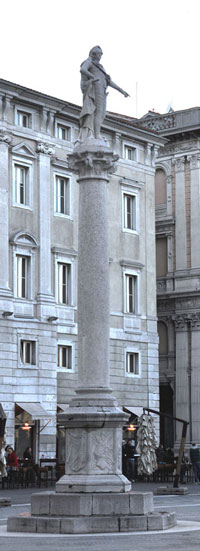 Base of the statue of Carlo VI D’Asburgo
Base of the statue of Carlo VI D’Asburgo
Excellent example of limestone with rudists. Several species can be recognized and thus we can tell the age and origin of the limestone. The present rudists are: Katzeria hercegovinaensis, Biradiolites sp., Radiolites dario. The limestone probably comes from Aurisina Roman Quarry (Upper Cretaceous, Santonian-Campanian 86-72 mya).
Columns of the Municipio
The loggia of the Municipio (city hall) is characterized by limestone columns splintered by German cannonades fired from the sea against Trieste City Hall during the Second World War (picture 6).
Instead, on the limestones edging the main entrance are observed the rudist fossils (Requienidae) (picture 6a).
Piazza della Borsa
Paved in sandstone slabs and ancient masegni. The sandstone slabs contain less marl than the ones in piazza dell’Unità, they do not have cracks or roundish holes made by marl erosion, and they are more compact and have fewer lines. You can observe some masegni rich in fossils (picture 7): locomotion/feeding structures produced in the sediment about 45 mya by worm-like organisms. These animals fed on organic substances contained in the sediment they were living in.
Palazzo della Borsa (1802-1806, A. Mollari )
The palace is neoclassical in style and its front, with a porch with four big columns in Aurisina limestone (Aurisina Fiorita), faces piazza della Borsa. In the limestone matrix you can observe some “flowers” made by fragments of rudist shells. The limestone is brooming (this surface is obtained with a bush hammer, a tool with pyramidal points. The repeated impact of these points into stone surface, create an irregular texture that resembles naturally weathered rock). At the base of the column you can see some Vaccinites; they are rudists with a strong shell and with pillars in the general cavity of the shell (like all the Hippuritidae). They come from paleo-environments with high energy and a lot of oxygen. In Trieste Karst they can be found in the limestones of the Upper Cretaceous, for example near Aurisina quarry.
Teatro Verdi (1798-1801, M. Pertsch)
The main front faces Piazza Verdi and has a porch supported by pillars in Istria stone, a Cretaceous limestone where you can observe some thin, parallel and superimposed plates. These plates are called stromatolites. On the front you can see the marks left by cannonades fired in 1813 during the fight between the French (who dominated the city at that time) and the Anglo-Austrians (picture 9a). The remains of the Frigate Napoleonica Danae, which belonged to the French military Navy and dates back to that period, are kept in the Civico Museo del Mare (Maritime Museum of Trieste) in Campo Marzio.
Palazzo Carciotti (1798-1805, M. Pertsch)
The main front faces the sea and has a base in bossage, made in Istria stone, where you can observe the stromatolites. They are in relief and in some points they are very eroded and damaged. Probably their being so near the sea (and they were even closer originally) made their erosion much easier.
Canal Grande
It was the main canal crossing the salt fields. In 1756 Maria Teresa had it enlarged and walled banks were added so as to enable the boats to reach the city centre and unload their wares. It was longer than today, nearly touched St Antonio’s church. The “garofalini”, bollards of the XVIII century in limestone with rudists, date back to that time; there are several sections of hardly identifiable rudists. The rudists are in relief because of the differential dissolution of the limestone, from the time of the bollard construction until now. The banks are made by big masegni, some of them with a hole in the middle. At the base of Ponterosso, on the square that supported the extendable bridge, there is an ancient hydrometer (1758) in limestone, which was used for the readings of the sea level (called “zero ponte rosso”).
Piazza S. Antonio Nuovo
In 1769 a baroque church, consecrated to Saint Anthony, was erected in the area at the end of the Canal Grande (it was later demolished; the present church was completed in 1849). In 1934 the canal was filled near the square; the square changed and became as we see it today: a fountain in the middle and six flowerbeds all around. The flooring is made of different kinds of limestone: limestone with Chondrodonta (probably from Istria), limestone with stromatolites (Istria stone), limestone with mud cracks, marble called “sea flower” etc. of different shapes and sizes. On the edge of the fountain, limestones with Caprinidae can be seen: rudists with a spirogyrate upper valve similar to a goat’s horn (hence its name). The longitudinal channels (pallial canals) can be seen in the thickness of the shell.
Glossario
SANDSTONES (masegni from the Latin machineus, a big millstone used in mills) : sedimentary rocks made by sands. The sandstone from Trieste comes from the FLYSCH (from the German “fliessen”, sliding ground), a sequence of sedimentary rocks (sandstone and marlstone) formed by the deposition of sandy and muddy sediments in a deep marine basin by current deposits (turbidites), during orogeny. Age of rock formation: 47 – 4 mya. Middle Eocene..
BRECCIA:clastic sedimentary rock, formed by fragments called clasts, bigger than 2 mm with angular clasts.
LIMESTONES: sedimentary rock composed largely of calcite, a mineral form of calcium carbonate (CaCO3). The limestones used in Trieste are formed from the calcareous skeletons of organisms such as corals, mollusks, foraminifera accumulated in a shallow tropical seabed (carbonate platform).
Age of rock formation: Cretaceous (125 – 66 mya). On the Trieste Karst, more recent limestones can be found (Liburnic Formation, Nummulite and Alveoline limestone) with a different fossiliferous content and formation environment. IS LIMESTONE MARBLE? For the geologist “marble” is a rock resulting from metamorphism of carbonatic rocks. The limestones of Trieste Karst are sedimentary rocks, no marble. Commercial and technical use apply the term “marble” to all lithotypes made up of different mineral with a average Mohs hardness of 3-4 (Mohs scale of mineral hardness characterizes the scratch resistance of minerals), that can be polished and processed, utilizable in various building and furnishing field. At the “commercial” level, limestone can be considered marbles..
CAPRINIDAE(Caprinidae): appeared in the Lower Cretaceous, around 120 mya and disappeared in the Cenomanian, 100.5 – 93.95 mya. They are a family of rudists characterized by a thick shell with longitudinal channels (pallial canals). They indicate a high energy paleoenvironment.
CHONDRODONTA:bivalve mollusks related to oysters, that became extinct in the Upper Cretaceous. On the Karst the Chondrodonta can be found in the Upper Cenomanian limestones (95-93.9 mya).
MARBLE: metamorphic rock formed after the recrystallization (due to high temperatures and pressures) of a sedimentary rock (limestone or dolostone). This process removes the sedimentary texture and structures of the original rocks (fossils, stratifications etc.).
Marble is then a pure rock (without stratifications) with a crystal structure, uniform grain and a saccharoidal texture (e.g. the Carrara marble).
MARSTONE: sedimentary rock formed by the cementation of muds.
MUD CRACKS (poligoni di disseccamento): sedimentary structures formed when a muddy sediment, exposed to sun and air, dries and contracts giving origin to polygonal fractures. Mud cracks are a sure indicator of surfacing.
RILLENKARREN (in tedesco) o scannellature: solution flutes or Rillenkarren, in German, are sharp-ridged grooves formed by the dissolution of carbonatic rocks by acid water.
RUDIST: group of extinct bivalves, with diverse valves (inequivalves), very different from today’s bivalves. Rudists appeared in the Late Jurassic (Oxfordian, 163.5-157.3 mya) and disappeared in the Cretaceous-Tertiary boundary, 66 mya, like the dinosaurs. They were sessil (attached to the substratum) and benthic (living on the sea floor) organisms, as single individuals or gregarious. They lived in the warm, shallow sea of Tethys. They were the typical “reef-builders” of the Cretaceous, but rudist formations were very different from coral reefs.
STILOLITES: particular veins, similar to the sutures of the human skull, that occur in limestones. They are originated by the dissolution of the calcium carbonate matrix of a limestone due to a pressure increase. (Matrix=the very fine material present within the space between the grains).
STROMATOLITES: layered accretionary structures formed by the trapping, binding and cementation of sedimentary grains (muds) by biofilms of microorganisms, especially cyanobacteria (blue-green algae). The algae/muds layered structures is called stromatolites, one of the oldest evidence of life on Earth. The ancient stromatolites date 3,500 million of years ago (Archean). Modern stromatolites are found in marine and lacustrine environments, particularly in tropical climates.
TRAVERTINO: concretionary limestone formed by the rapid precipitation of calcium carbonate from water at the mouth of springs, falls or lakes. The rapid precipitation of calcium carbonate incorporates vegetal remains (leaves, twigs). Their subsequent decomposition and dissolution contributes to the characteristic porosity of travertine. .
